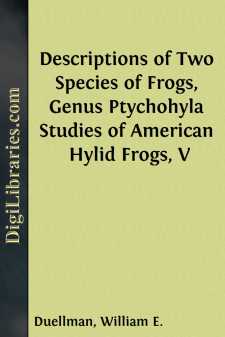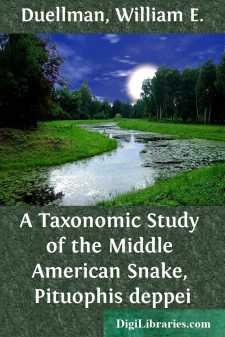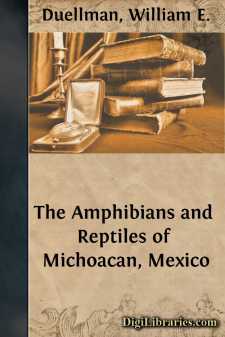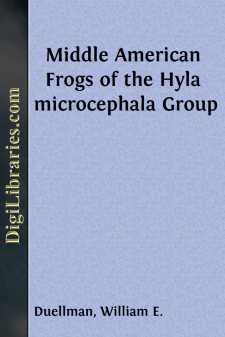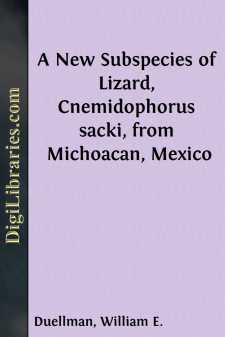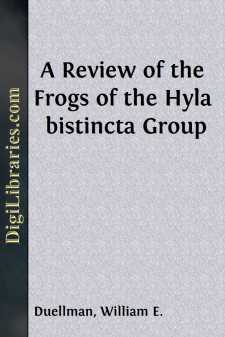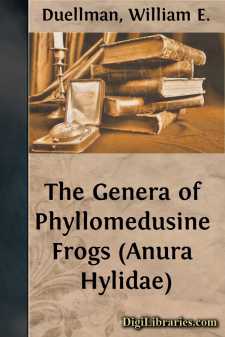Categories
- Antiques & Collectibles 13
- Architecture 36
- Art 48
- Bibles 22
- Biography & Autobiography 813
- Body, Mind & Spirit 142
- Business & Economics 28
- Children's Books 14
- Children's Fiction 11
- Computers 4
- Cooking 94
- Crafts & Hobbies 4
- Drama 346
- Education 46
- Family & Relationships 57
- Fiction 11829
- Games 19
- Gardening 17
- Health & Fitness 34
- History 1377
- House & Home 1
- Humor 147
- Juvenile Fiction 1873
- Juvenile Nonfiction 202
- Language Arts & Disciplines 88
- Law 16
- Literary Collections 686
- Literary Criticism 179
- Mathematics 13
- Medical 41
- Music 40
- Nature 179
- Non-Classifiable 1768
- Performing Arts 7
- Periodicals 1453
- Philosophy 64
- Photography 2
- Poetry 896
- Political Science 203
- Psychology 42
- Reference 154
- Religion 513
- Science 126
- Self-Help 84
- Social Science 81
- Sports & Recreation 34
- Study Aids 3
- Technology & Engineering 59
- Transportation 23
- Travel 463
- True Crime 29
Descriptions of Two Species of Frogs, Genus Ptychohyla Studies of American Hylid Frogs, V
Description:
Excerpt
Field studies on hylid frogs in southern México and northern Central America have resulted in the collection of numerous specimens of Ptychohyla, a genus of hylid frogs heretofore poorly represented in museum collections. Experience with the living frogs in their natural habitats has been helpful in defining the species and in formulating ideas concerning their relationships.
Taylor (1944) proposed the generic name Ptychohyla for a new species of frog, Ptychohyla adipoventris [= Ptychohyla leonhard-schultzei (Ahl)—fide Duellman, 1960] from Agua del Obispo, Guerrero. Taylor defined the genus as having large ventrolateral glands and horny nuptial spines in males. Stuart (1954:169) discussed the generic characters and pointed out that both the ventrolateral glands and horny nuptial spines were seasonal in their development, being found only in breeding males. Stuart then went on to describe Ptychohyla schmidtorum, a species characterized by the absence of horny nuptial spines in breeding males. My investigations of these frogs have revealed the presence of two groups of species. In both groups breeding males have large ventrolateral glands, but the two groups are easily separated by four characters. The first group contains, among others, Ptychohyla leonhard-schultzei, euthysanota, spinipollex, and another species in the Mesa Central of Chiapas to which I tentatively apply the name Ptychohyla macrotympanum (Tanner), 1957. This group of species is characterized by horny nuptial spines in breeding males, presence of a tarsal fold, a call consisting of a single long note, and tadpoles having lips not greatly expanded. The second group, as recognized here, is characterized by the absence of horny nuptial spines in breeding males, lack of a tarsal fold, a call consisting of a series of short notes, and tadpoles having greatly expanded lips. In this group belong Ptychohyla schmidtorum and the two species described below.
Only the descriptions of the new species are given in this paper; detailed comparisons, descriptions of osteological features, analyses of calls, and discussions of relationships are reserved for a forthcoming review of the entire genus.
In the spring of 1959, collections of amphibians and reptiles were made in the cloud forests on the northern slopes of the Sierra Madre Oriental in northern Oaxaca. Among the hylids found, two specimens of a heretofore unnamed species of Ptychohyla have brilliant red flash-colors on the groin and thighs; in allusion to these fiery colors I propose that this species be named:
Ptychohyla ignicolor new species
(Plate 25,
)Holotype.—University of Michigan Museum of Zoology No. 119603, from a stream 6 kilometers south of Vista Hermosa, Oaxaca, México (1865 meters); obtained on March 31, 1959, by Thomas E. Moore. Original Number WED 14159.
Paratype.—UMMZ 119602 from Vista Hermosa, Oaxaca (1500 meters); obtained on March 30, 1959, by William E. Duellman.
Diagnosis.—A species of the schmidtorum-group of Ptychohyla differing from other known members of the group in having the diameter of the tympanum less than one-half the diameter of the eye, no white spot below the eye, no lateral light stripe, bright green dorsum in life and red flash-colors on groin and thighs.
Description of Holotype.—Adult male having a snout-vent length of 30.0 mm.; tibia length, 14.6 mm.; tibia length/snout-vent length, 48.7 per cent; foot length (measured from proximal edge of inner metatarsal tubercle to tip of longest toe), 12.3 mm.; head length, 9.2 mm.; head length/snout-vent length, 32.3 per cent; head width, 9.3 mm.; head width/snout-vent length, 31.0 per cent; diameter of eye, 3.2 mm.; diameter of tympanum, 1.3 mm.; tympanum/eye, 40.6 per cent....


